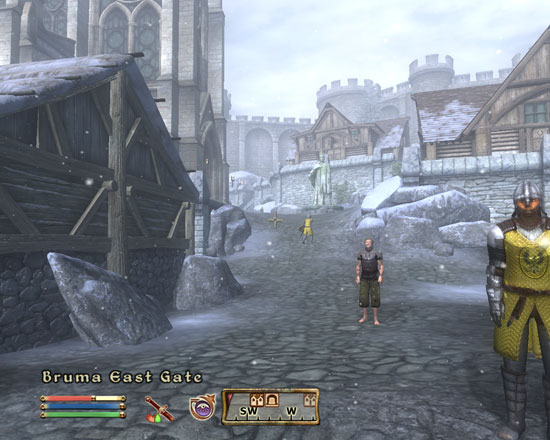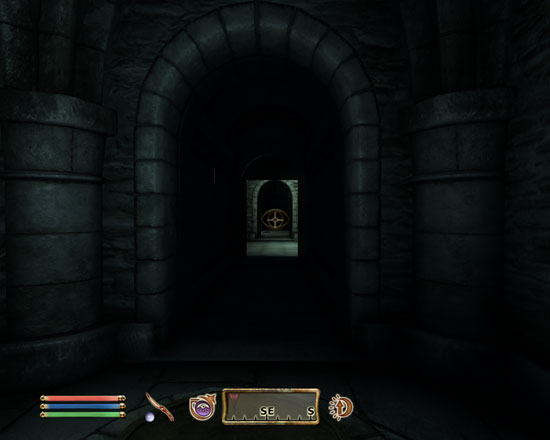The Elder Scrolls IV: Oblivion GPU Performance
by Anand Lal Shimpi on April 26, 2006 1:07 PM EST- Posted in
- GPUs
When both Doom 3 and Half Life 2 came out we burned the midnight oil trying to put together guides for CPU and GPU performance in the games as soon as they were released. Much to our surprise, especially given the performance hype that had preceeded both of them, both games ran relatively well on most mainstream hardware that was available at the time. One GPU generation later and the worries about performance under Doom 3 and Half Life 2 were yesterday's news. The same, unfortunately, cannot be said about Bethesda Softworks' latest immersive RPG: Oblivion.
The game itself is more addicting and immersive than any of its predecessors and its reviews confirm that. But we're not here to tell you that the game is great, we're here to tell you what you need to run it. The fact of the matter is that Oblivion is the most stressful game we've ever encountered, taking the crown away from F.E.A.R. as something that simply doesn't run well on anything. Obtaining good performance under Oblivion is so hard that a number of optimization guides have popped up helping users do whatever it takes to make the game playable. At AnandTech we've been using the Oblivion Tweak Guide from Tweakguides.com and recommend reading it if you're looking to get a good idea for the impact of the many visual settings available in the game.
Just as we've done in our previous articles on Doom 3 and Half Life 2, we're splitting our Oblivion performance coverage into multiple parts. This first part will focus on high-end and mid-range PCIe GPU performance and future articles will look at CPU performance as well as low-end GPU and AGP platform performance if there is enough demand for the latter two. Where we take this series of articles in the future will depend on many of your demands and requests, so please make them heard.
Benchmarking Oblivion
There are really three types of areas you encounter while playing Oblivion, you'll find your character either: 1) Outdoors, 2) Inside a town but still outdoors, or 3) Inside a building or dungeon. Interestingly enough, our seemingly haphazard list of Oblivion locales is actually organized in ascending order of performance. You'll encounter your absolute highest performance inside buildings while you'll actually contemplate spending $1200 on graphics cards whenever you find yourself outside. It only made sense that we benchmarked in each of those three areas, so we constructed manually scripted (read: walk-throughs by hand) benchmarks taking us through one of each type of area in Oblivion.

Oblivion Gate Benchmark
The first test is our Oblivion Gate benchmark, which just so happens to be the most stressful out of all three. In this test we've spotted an Oblivion gate in The Great Forest and walk towards it as scamps attempt to attack our character. The benchmark takes place in a heavily wooded area with lots of grass; combined with the oblivion gate itself, even the fastest GPUs will have trouble breaking 30 fps here.

Town Benchmark
The next test takes place in the town of Bruma and simply features our character walking through a portion of the town. There are a few other characters on screen but no major interaction takes place. Despite the simplicity of the test, since it takes place outside the frame rate is already quite stressful on some mid-range GPUs.

Dungeon Benchmark
Our final test takes place in the Sanctum on our way to the Imperial City prisons; this "Dungeon" benchmark showcases indoor area performance and consists of our character sneaking through the dimly lit Sanctum. There are guards around however none appear in the view of our character. Many cards will do well in this test, but unless they can pass the first benchmark their performance here is meaningless.
We measured frame rates using FRAPS and reported both the minimum and average frame rates in our charts (we left out maximum frame rates because they simply aren't as important and they made the graphs a little too difficult to read when we included them). The minimum frame rates are indicated by a vertical white line inside the bar representing average frame rate.
Since we measured performance using FRAPS and not through a scripted timedemo sequence, the amount of variance between runs is higher than normal; differences in performance of 5% or less aren't significant and shouldn't be treated as such.










100 Comments
View All Comments
JarredWalton - Thursday, April 27, 2006 - link
I can't say I'd even begin to consider DOAC as better looking graphics. But if that's what you like, more power to you.dhei - Thursday, April 27, 2006 - link
Thats easy to say when you prob don't play it currently. It has all the graphics features you see in Oblivion minus maybe HDR.
ueadian - Thursday, April 27, 2006 - link
Lol are you serious? DAoC might look better while you are smoking the reefer bud but I've played it many times and Oblivion blows it away graphicaly.dhei - Thursday, April 27, 2006 - link
Well your doing drugs to think oblvion has good graphics. I consider them medicore compared to other games of same kind, has I have seen people play the game.DAOC graphics look a ton better to me imo...drug free..
hondaman - Wednesday, April 26, 2006 - link
Why play oblivion instead of MMO?1. No monthly fees
2. Oblivion has an end. MMO doesnt. Thats a good thing for those of us with lives, but little self control.
3. No annoying kids to deal with.
4. No annoying cliques
5. No annoying server downtimes.
6. Not having to answer "a/s/l" every 30 seconds.
There is a pleasant serenity about single player RPG's that is impossible with MMO.
TejTrescent - Wednesday, April 26, 2006 - link
But hmm.My rig is no where close to the rig that you guys used for comparison, and I don't know my exact framerates because I've not yet ran FRAPS with Oblivion, but..
My 3500+ Newcastle, not overclocked, with 2GB of Corsair/Mushkin running dual channel at 2.5-3-3-7, with my AGPx8 6800OC from BFGTech (not overclocked any further either).. I pull highly playable framerates (aka no choppiness unless I'm getting jumped by 6+ Daedric mages, that lightning is killer) at settings MILDLY better than the medium GPU ones (though still 1024x768, just higher fade rates), no tweaks on either. I can even run MediaMonkey for music in the background without any choppy feelings.
I guess Oblivion isn't very CPU dependant or gains anything from multithreads really or something, because huh. I mean, I can't believe my crappy 3500+ is keeping decent pace with an FX60. o_o And better RAM. Just huh. I can generally tell if a framerate falls below 24 thanks to FPS games being painful at any lower than that.. and just huh. Weiird.
JarredWalton - Wednesday, April 26, 2006 - link
I would say there's a good chance your framerates are below 20 on a regular basis in the wilderness. FX-60, 7900 GT SLI, 2GB RAM, 2x150GB Raptors, and at Fort Bloodford looking towards the closest Oblivion Gate, I pull 13-15 FPS. (1920x1200, most detail settings at high.) I've also found that lowering a lot of settings doesn't have much of an impact. The various "fade" settings don't do much for me.Open the console and type "TDT" to see your frame rates. I personally find anyting above 15 FPS to be acceptable for Oblivion, but opinions vary. :)
TejTrescent - Wednesday, April 26, 2006 - link
Well.. I'll check it out later tonight, but if they are, it's absolutely the smoothest sub 20fps I've ever seen.Lot more playable than UT2004, Painkiller, FarCry, or... pretty much anything else on this comp. XD
TejTrescent - Thursday, April 27, 2006 - link
Wish there was an edit because I feel stupid replying to myself, but. Huh.18-30 outside commonly, 18-35 in the city, and consistent 25-35 in dungeon areas.
I am so so confused right now. The 18 isn't even noticeable. How did they.. what did they.. wha.. Guess it's just the slower pace making it less noticeable..
nullpointerus - Thursday, April 27, 2006 - link
Uh...I'm not a graphics guru, but is it possible that the dips in fps are smoother? If we draw a graph with "1" indicating a frame draw and "x" indicating stalling of some kind - such as processing sound, physics, or waiting on the GPU hardware - then I can illustrate what I'm talking about.1xx1xx1xx1xx1xx
1xx1xx1xx1xx1xx
1xx1xx1xx1xx1xx
1xx1xx1xx1xx1xx (20 fps on a 60Hz display - balanced)
1xxxx11xx1xxx1x
1xxxx11xx1xxx1x
1xxxx11xx1xxx1x
1xxxx11xx1xxx1x (20 fps on a 60Hz display - choppy)
Or do 3D games not work like this?